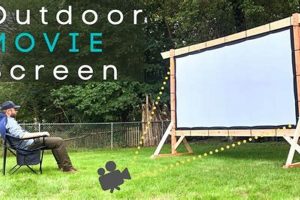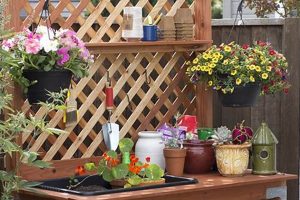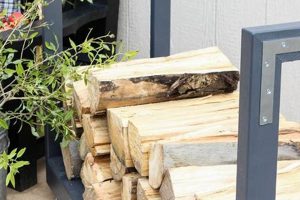The creation of furnishings for exterior spaces, undertaken by individuals using their own skills and resources, represents a significant trend in home improvement. This encompasses a wide range of projects, from simple benches constructed from reclaimed wood to elaborate patio sets fashioned from repurposed materials. The resulting items are intended for use in gardens, patios, decks, and other exterior environments.
This activity offers numerous advantages, including cost savings, customization options, and the satisfaction of creating unique pieces. Historically, self-made outdoor furnishings have been a practical necessity for those seeking affordable alternatives. Currently, the practice aligns with broader movements towards sustainability and personalized design, allowing individuals to exert control over the aesthetics and functionality of their outdoor living areas.
Subsequent sections will delve into specific project ideas, material selection considerations, essential tools and techniques, and strategies for ensuring the durability of self-constructed outdoor furniture. This comprehensive exploration aims to equip individuals with the knowledge and resources necessary to successfully undertake such endeavors.
Essential Guidance for Exterior Furnishing Projects
Effective self-directed outdoor furniture construction requires careful planning and execution. The following guidelines offer valuable insights for achieving successful and durable results.
Tip 1: Material Selection is Paramount: Prioritize weather-resistant materials such as treated lumber, cedar, teak, or recycled plastic. These materials withstand exposure to the elements, minimizing deterioration and extending the lifespan of the finished product. For metal components, consider powder-coated aluminum or stainless steel to prevent rust.
Tip 2: Prioritize Accurate Measurements and Precise Cuts: Precise measurements and accurate cuts are fundamental to achieving structurally sound and aesthetically pleasing pieces. Invest in quality measuring tools and cutting equipment, and double-check all dimensions before proceeding with assembly. Utilize jigs and clamps to ensure consistent angles and secure joints.
Tip 3: Employ Appropriate Joinery Techniques: The chosen joinery methods should be suitable for outdoor use. Mortise and tenon joints, dovetail joints, or pocket hole joinery, when properly executed with exterior-grade adhesive, provide robust and durable connections. Reinforce joints with screws or bolts as necessary for added strength.
Tip 4: Apply Protective Finishes: Protect the finished furniture with weather-resistant stains, paints, or sealants. These finishes create a barrier against moisture, UV radiation, and fungal growth. Reapply finishes periodically, as recommended by the product manufacturer, to maintain protection and extend the furniture’s lifespan.
Tip 5: Consider Ergonomics and Comfort: Design and construct furniture that is comfortable and ergonomic. Account for appropriate seat heights, back angles, and armrest placements. Incorporate cushions or padding made from weather-resistant fabrics for added comfort and visual appeal.
Tip 6: Plan for Drainage: Incorporate drainage features into the design to prevent water accumulation. Drill drainage holes in seats and tabletops to allow rainwater to escape. Angle surfaces slightly to promote runoff and minimize standing water.
Tip 7: Adhere to Safety Precautions: Always wear appropriate safety gear, including eye protection, ear protection, and gloves, when working with power tools and materials. Work in a well-ventilated area and follow the manufacturer’s instructions for all tools and products.
Adherence to these principles enhances the longevity, structural integrity, and aesthetic appeal of self-made exterior furnishings, yielding functional and visually pleasing additions to outdoor living spaces.
The following section will address design considerations and inspirations for upcoming outdoor furnishing endeavors.
1. Material Weather Resistance
The durability and longevity of do-it-yourself outdoor furniture are intrinsically linked to the weather resistance of the materials employed. In the absence of appropriate material selection, exposure to environmental elements such as rain, sunlight, temperature fluctuations, and humidity will inevitably lead to deterioration, structural failure, and reduced service life. For example, untreated softwood used in an outdoor bench construction will rapidly succumb to rot and insect infestation, rendering the piece unusable within a relatively short period. Conversely, the use of naturally weather-resistant hardwoods like teak or cedar, or pressure-treated lumber, significantly mitigates these risks.
The selection of weather-resistant materials necessitates a comprehensive understanding of the specific environmental challenges present in the intended outdoor location. Coastal environments, for example, demand materials resistant to saltwater corrosion, while regions with high UV indices require materials that can withstand prolonged sun exposure without degradation. Furthermore, appropriate surface treatments, such as paints, stains, and sealants, play a crucial role in augmenting the weather resistance of even inherently durable materials. For instance, a well-applied marine-grade varnish can significantly extend the lifespan of a wooden table exposed to frequent rainfall.
In summary, material weather resistance is a foundational consideration in self-directed outdoor furnishing projects. Neglecting this aspect inevitably leads to premature failure and increased maintenance requirements. A thorough assessment of environmental conditions, coupled with informed material selection and appropriate surface treatments, is essential for creating durable and aesthetically pleasing outdoor furniture that can withstand the elements for years to come.
2. Structural Integrity
Structural integrity forms the bedrock upon which successful self-made outdoor furniture projects are built. Its relevance is paramount, ensuring that the finished product not only meets aesthetic expectations but also withstands the rigors of outdoor use, maintaining its functionality and safety over extended periods. A deficiency in structural integrity can lead to premature failure, posing potential safety hazards and negating the time and resources invested in the project.
- Joint Strength and Stability
Joint strength and stability are crucial elements. Proper joinery techniques, such as mortise and tenon, dovetail, or robust screw and adhesive combinations, are essential to resist forces exerted on the furniture. A poorly constructed joint is a common point of failure. For example, a simple butt joint held only with nails in a heavy outdoor bench will likely separate under repeated stress and weight. Proper bracing and reinforcement around joints also contribute significantly to overall stability.
- Load-Bearing Capacity
Load-bearing capacity directly relates to the furniture’s ability to support weight without deformation or collapse. Material selection and design play critical roles in determining load-bearing capacity. Thicker lumber and strategically placed supports are essential for items designed to support significant weight, such as benches or tables intended for dining. Overlooking load-bearing requirements can lead to catastrophic failure, potentially causing injury.
- Resistance to Environmental Factors
Outdoor furniture is continuously exposed to environmental factors, including wind, rain, and temperature fluctuations. Structural integrity must account for these stressors. For example, repeated wetting and drying cycles can weaken wood joints, leading to loosening and eventual failure. Using weather-resistant materials and appropriate protective finishes can mitigate these effects and maintain structural integrity over time.
- Foundation and Support System
The foundation or support system is fundamental to distributing weight evenly and preventing instability. A level and stable base is essential, especially on uneven ground. Uneven weight distribution can create stress points that compromise structural integrity. Adjustable feet or a properly constructed foundation can ensure stability on various surfaces, extending the lifespan of the furniture.
These facets of structural integrity are not isolated concerns; they are interconnected and interdependent. A well-designed piece of exterior furniture considers all these factors holistically. By prioritizing strong joinery, appropriate load-bearing capacity, resistance to environmental stressors, and a solid foundation, self-directed furniture projects can yield durable and safe additions to outdoor living spaces. The ultimate success hinges on a thorough understanding of these principles and their careful application throughout the design and construction process.
3. Ergonomic Design
Ergonomic design principles hold significant relevance in the realm of self-directed outdoor furniture construction. The application of ergonomics aims to optimize human well-being and overall system performance by aligning the furniture’s design with the physical and cognitive capabilities of the user. Neglecting these principles in projects intended for outdoor use can lead to discomfort, strain, and potential long-term health issues, thereby diminishing the intended benefits of the outdoor space. A common example is the construction of a patio chair with an excessively low seat, which may induce lower back pain and difficulty rising, particularly for individuals with mobility limitations. The intended relaxation and enjoyment are therefore undermined by poor design.
The incorporation of ergonomic considerations into self-made outdoor furniture requires a deliberate approach during the design phase. This includes accurate measurement of seat heights, back angles, and armrest placements to ensure proper posture and support. Furthermore, attention should be given to the materials used; smooth, splinter-free surfaces and appropriate cushioning are vital to prevent discomfort and pressure points. Consideration must also be given to the intended users; furniture designed for children, for instance, should differ in scale and features from furniture intended for adults. Beyond individual pieces, the layout of the outdoor space as a whole should promote natural movement and interaction, minimizing awkward reaching or prolonged static postures. The strategic placement of tables, chairs, and pathways should align with common usage patterns, allowing users to navigate and interact with the space comfortably and efficiently.
In conclusion, ergonomic design is not merely an optional add-on but a fundamental aspect of successful self-made outdoor furniture. Prioritizing user comfort, safety, and well-being yields furniture that is not only aesthetically pleasing but also functional and conducive to a positive outdoor experience. The challenges lie in acquiring sufficient knowledge of ergonomic principles and applying them effectively within the constraints of available materials and construction skills. However, the benefits of enhanced comfort, reduced physical strain, and improved overall enjoyment of the outdoor space significantly outweigh the effort required. By integrating ergonomic considerations, self-directed furniture construction can transform outdoor areas into inviting and healthful extensions of the home.
4. Protective Finishing
Protective finishing constitutes a critical phase in self-directed outdoor furniture construction, influencing the long-term performance and aesthetic appeal of the completed pieces. Untreated or inadequately finished furniture intended for exterior use is vulnerable to a range of environmental stressors, resulting in accelerated degradation and diminished service life. The direct correlation between the application of suitable protective finishes and the extended viability of self-made outdoor furnishings is demonstrably clear. For instance, a wooden garden bench left unfinished will, over time, succumb to moisture absorption, leading to warping, cracking, and fungal decay. Conversely, a similar bench treated with a penetrating oil-based sealant will exhibit significantly enhanced resistance to these environmental factors, maintaining its structural integrity and appearance for a considerably longer duration.
The selection of an appropriate protective finish necessitates careful consideration of the furniture’s intended function, the type of material used in its construction, and the prevailing climate conditions. Wood, for example, may benefit from penetrating oils, stains, varnishes, or paints, each offering varying degrees of protection against moisture, ultraviolet radiation, and abrasion. Metal components often require coatings designed to prevent rust and corrosion, such as powder coating or specialized metal paints. The application process is equally important, demanding meticulous surface preparation, even distribution of the finish, and adherence to the manufacturer’s instructions. Furthermore, periodic reapplication of protective finishes is often necessary to maintain their effectiveness, particularly in harsh outdoor environments. A failure to perform routine maintenance, such as reapplying sealant to a wooden deck chair, can negate the initial protective measures and lead to premature deterioration.
In summary, protective finishing is not merely a cosmetic addition but an essential investment in the longevity and value of self-made outdoor furniture. Its importance stems from its ability to mitigate the damaging effects of environmental exposure, preserving both the structural integrity and the aesthetic appeal of the finished product. Recognizing the cause-and-effect relationship between protective finishes and furniture durability, understanding the range of available options, and adhering to proper application and maintenance protocols are all crucial to achieving successful and sustainable outdoor furnishing projects. The primary challenge lies in selecting the correct product and technique, as the optimal choice varies depending on the materials used and the specific environmental conditions encountered. A careful assessment of these factors ensures that the finished furniture can withstand the elements and provide years of reliable use.
5. Sustainable Sourcing
The integration of sustainable sourcing practices within the realm of self-directed outdoor furniture projects directly impacts environmental conservation and resource management. The selection of materials for these endeavors carries significant consequences, determining the ecological footprint and long-term environmental impact of each completed piece. Uninformed material choices, such as reliance on unsustainably harvested timber or the utilization of virgin plastics, contribute to deforestation, habitat degradation, and the depletion of non-renewable resources. Conversely, prioritizing sustainably sourced alternatives offers a pathway to mitigate these adverse effects. For example, employing reclaimed lumber sourced from deconstructed buildings reduces demand for newly harvested trees, effectively diverting usable material from landfills. Similarly, selecting recycled plastic derived from post-consumer waste reduces reliance on petroleum-based materials and lessens plastic pollution. These deliberate choices reflect a commitment to responsible consumption and environmental stewardship.
The practical application of sustainable sourcing extends beyond material selection to encompass the entire lifecycle of the furniture. Designers and builders can optimize material usage to minimize waste through careful planning and efficient cutting techniques. Durable designs and robust construction, paired with appropriate protective finishes, increase the longevity of the furniture, reducing the frequency of replacement and associated material consumption. Furthermore, end-of-life considerations, such as designing for disassembly and component reuse or selecting materials that can be readily recycled, further minimize environmental impact. A well-documented example involves the use of modular construction techniques, enabling the easy replacement of damaged parts, extending the overall lifespan of the furniture. Such practices enhance the overall resource efficiency and sustainability profile of self-made outdoor furniture.
The incorporation of sustainable sourcing within self-directed outdoor furniture projects presents both opportunities and challenges. While the environmental benefits are substantial, challenges may arise from the limited availability or higher cost of sustainably sourced materials in certain regions. Overcoming these challenges requires proactive research, collaboration with local suppliers, and a willingness to adapt designs to accommodate available resources. However, the broader trend towards increased environmental awareness and the growing demand for sustainable products are driving innovation and expanding access to environmentally responsible materials. Ultimately, integrating sustainable sourcing into outdoor furniture projects represents a tangible step toward promoting responsible consumption, minimizing environmental impact, and contributing to a more sustainable future. The cumulative effect of these individual efforts contributes significantly to a broader shift toward environmental responsibility within the construction and manufacturing sectors.
Frequently Asked Questions
The following questions address common inquiries regarding the construction, maintenance, and sustainability of self-made furnishings intended for outdoor use.
Question 1: Which wood species exhibit superior resistance to decay when used in exterior applications?
Naturally durable wood species, such as cedar, teak, and redwood, demonstrate inherent resistance to decay and insect infestation. Pressure-treated lumber provides a more economical alternative, but its chemical composition warrants careful consideration.
Question 2: What joinery techniques are most suitable for ensuring structural stability in outdoor furniture exposed to varying weather conditions?
Mortise and tenon joints, dovetail joints, and robust screw and adhesive combinations provide enhanced stability compared to simpler joinery methods. Proper bracing and reinforcement are also essential for resisting stress.
Question 3: What protective finishes offer optimal resistance to ultraviolet radiation and moisture penetration for wooden outdoor furniture?
Marine-grade varnishes and oil-based sealants containing UV inhibitors provide a durable barrier against environmental elements. Regular reapplication is necessary to maintain optimal protection.
Question 4: How can individuals ensure the ergonomic design of self-made outdoor furniture to maximize user comfort and minimize physical strain?
Careful consideration must be given to seat height, back angle, and armrest placement. Proper lumbar support and appropriate cushioning are also essential for promoting ergonomic comfort.
Question 5: What sustainable sourcing practices can be implemented in self-made outdoor furniture projects to minimize environmental impact?
Utilizing reclaimed lumber, recycled plastics, and sustainably harvested wood species minimizes demand for virgin resources. Efficient material usage and durable construction further reduce environmental impact.
Question 6: How frequently should protective finishes be reapplied to outdoor furniture to maintain its integrity and aesthetic appeal?
The frequency of reapplication depends on the type of finish, the climate conditions, and the level of exposure. Generally, annual or biannual reapplication is recommended for optimal protection.
Adherence to these principles promotes the creation of durable, comfortable, and environmentally responsible self-made furnishings, enhancing the enjoyment and sustainability of outdoor living spaces.
The next section will address potential project ideas and design inspirations for self-made outdoor furniture endeavors.
DIY Furniture Outdoor
The preceding discussion elucidates the core elements of undertaking the construction of self-made furnishings for exterior environments. Key considerations include the strategic selection of weather-resistant materials, the implementation of robust joinery techniques to ensure structural integrity, the deliberate incorporation of ergonomic design principles, the application of protective finishes to mitigate environmental degradation, and the adherence to sustainable sourcing practices to minimize ecological impact. Each of these facets contributes significantly to the overall durability, functionality, and environmental responsibility of such projects.
Effective implementation of these principles transforms exterior spaces into both aesthetically pleasing and ecologically sound environments. The longevity and value of these endeavors rest upon a comprehensive understanding of materials, techniques, and environmental considerations. The diligent application of this knowledge ensures the creation of enduring and environmentally conscious additions to outdoor living areas.







